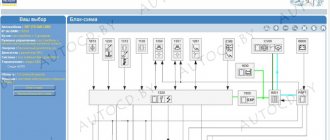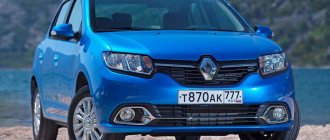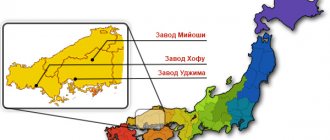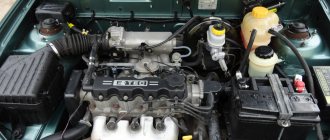Features of the sedan
Cars with affordable prices and excellent technical characteristics are valued not only in the CIS countries, but also in Russia. To satisfy all the wishes of Russian buyers, the French concern Peugeot-Citroen created the model 408. It is known where the Peugeot 408 is produced, now let’s talk in more detail about the capabilities of this car. This car model cannot be called small; it can easily be classified as a D-class. Thanks to the increase in the dimensions of the car, the inside of the sedan has become much more comfortable and spacious. The dimensions of the Peugeot 408 are 4337 mm × 4703 mm × 1505 mm. Our compatriots are very fond of this car model; the owners speak especially positively about the car’s engine.
The Peugeot 408 sedan is equipped with a 150-horsepower turbocharged engine with a volume of 1.6 liters. The car's suspension is also excellent. Despite the quality of Russian roads, this nimble sedan copes with all obstacles and potholes with a bang. In addition to an engine with a power of 150 horsepower, Russian buyers can purchase a sedan with a 1.6-liter gasoline unit producing 110 horsepower, or an engine with the same volume, but with a power of 120 horsepower. A turbodiesel consumes five liters of fuel per hundred kilometers, while gasoline units consume a little more - 8.2 liters. The car is offered with both a 5-speed manual and automatic transmission. The volume of the luggage compartment of the car is 560 liters.
But by folding the rear seats, you will be able to increase it. The luggage compartment has its own “zest”. Where the Peugeot 408 is produced, a plastic cover for the front bumper grille is placed there. The manufacturer recommends that owners use this part in the winter. It will protect the engine compartment from snow, sand, and dirt. It also helps the engine warm up faster. Since the body is galvanized, the manufacturer provides a 12-year guarantee against corrosion.
Peugeot country of origin: are all models assembled in France?
The Peugeot Partner utility vehicle was presented to the general public in 1997. With rather modest golf-class dimensions, the car had the carrying capacity of an average commercial van. The cabin comfortably accommodated five people, including the driver, and there was an impressively sized trunk in the back. In addition to its capacity and impressive carrying capacity, the vehicle had good speed characteristics. Fully loaded and on a good road, the Peugeot Partner reached a speed of 90 km/h.
The car was created on the basis of the Peugeot 306 and was produced in a cargo-passenger format for six years without any changes. In 2002, the car was restyled, after which the popularity of the Peugeot Partner car increased even more, although the changes were not so significant. The updated van was equipped with large headlights, the radiator grille was modernized and the contours of the front end were slightly modified. The main element of the exterior was the stylish “kenguryatnik” on the front bumper. The arches could be chrome-plated or painted in body color.
The front optics included side lights, high and low beam headlights, and turn signals. The taillights and interior lighting remain unchanged. The restyled car, among other things, received an additional brake light located under the rear bumper, a special automatic valve that tightly shuts off the gas supply in the event of an accident, side airbags in addition to the front ones, and seat belts with effective pretensioners.
The Peugeot Partner model range includes several modifications, including:
- rear-wheel drive double cargo van with a body equipped for transporting various cargoes with a total weight of 800 kg;
- a cargo van with all-wheel drive, two front seats and two folding stools in the cargo area, designed to load up to 600 kg;
- cargo-passenger version, five-seater, quite comfortable, called Combi;
- 5-seater CombiSpace cargo-passenger version with reinforced rear suspension.
All modifications during the restyling process received a new interior, equipped with a universal instrument panel and a center console with a liquid crystal display in the center. The on-board mini-computer displayed all the data regarding the technical condition of the machine, maintenance periods and standards for consumables. On the spokes of the comfortable steering wheel there are buttons for controlling the air conditioning, audio system, and windshield wipers.
The seats have a pronounced ergonomic shape and are covered with thin velor; the entire interior upholstery is designed in a combination of two colors. The lighting of the interior space is soft and has a relaxing effect. The entire interior gives the impression of coziness.
At the very beginning of 2008, the Peugeot Partner car was presented in the top body version B9. The second generation car was called Peugeot Partner Tepee. It was built on PSA platform No. 2 for middle-class cars. The difference was noticeable; the Peugeot Partner Tipi looked like an independent model. Compared to the previous Peugeot, the new version was 240 mm longer and 130 mm wider. The wheelbase has also increased by 40 mm.
The cargo version of the second generation was still called “Peugeot Partner”. The body has become wider and more voluminous, making it possible to transport objects up to three meters long. The machine's carrying capacity increased to 850 kg, and the volume of the working area was 3.5 cubic meters.
The passenger Peugeot Partner Tipi has also become more spacious and the interior has become more comfortable. Countless shelves and shelves, various kinds of pockets and niches appeared. Most of these devices remain unused, but the desire of car manufacturers to increase the level of comfort deserves respect.
Peugeot Partner, whose diesel engine developed only 75 hp, needed more powerful traction. As an alternative, a Partner Tepee 1.6 petrol engine with a volume of 1587 cc was proposed. cm with fuel injection. The engine power was 90 hp, and this option fully met the needs of the car.
Partner Tepee 1.6 engine characteristics:
- type - gasoline, injection;
- number of cylinders - 4;
- number of valves - 16;
- piston stroke - 82 mm;
- cylinder diameter - 78.5 mm;
- working volume - 1587 cubic meters. cm;
- power - 90 hp
Later, another version of the gasoline engine with a power of 110 hp appeared.
The Peugeot Partner car has the following dimensional data:
- length - 4380 mm;
- height - 1875 mm;
- width - 1810 mm;
- wheelbase - 2728 mm;
- curb weight - 1472 kg;
- total weight - 2021 kg;
- load capacity - 553 kg.
A cargo-passenger van is usually operated in fairly harsh conditions. Breakdowns, although not often, still happen. Repairs are sometimes necessary. Spare parts for the model in question are currently available in a full range. Depending on the complexity, Peugeot-Partner repairs can be done on your own in a workshop or contact a service center. If the repair concerns the chassis, then special equipment will be required to adjust the camber and toe of the wheels.
Over its 18-year history, the popular van has received many positive reviews. The owners noted the machine’s reliability, impressive load capacity, and high level of comfort. The Peugeot Partner, reviews of which have always been only positive, is still one of the most popular cars in its class today.
Materials: https://www.syl.ru/article/183147/new_pejo-partner—kompaktnyiy-pikap-frantsuzskogo-proizvodstva
Advantages and disadvantages of Peugeot 408
Regarding the quality of materials and workmanship, there is interesting information. As it turned out, to assemble the Peugeot 408 at the PSMA enterprise, they use American seats, plastic and upholstery materials from the French, and the bumpers for the sedan are produced by the domestic company Magna. This car model, like any other, has its pros and cons. First, the good stuff. The Peugeot 408 has the largest dimensions in its segment. Also, the advantages include:
- high ground clearance
- spacious trunk
- rear wide and comfortable seat for passengers
- high level sound insulation
- wide engine range
- opportunity to take out a car loan on favorable terms
- low cost sedan
- perfectly adapted for use in the Russian Federation.
Where the Peugeot 408 is assembled, some mistakes were made:
- it takes a long time to warm up the interior
- The luggage compartment is difficult to open
- wipers don't work well
- it takes effort to close the door
- narrow luggage compartment opening.
The sedan from the French manufacturer is a very affordable vehicle that will suit even the most ordinary buyer. The basic version of the sedan will cost 549,000 rubles. A car with a 1.6-liter diesel unit (112 horsepower) costs more – 637,000 rubles. Peugeot 408 with a turbocharged 150-horsepower engine and automatic transmission is sold at a price of 746,000 rubles. For additional options and bells and whistles, the buyer will need to pay extra in the region of ten thousand rubles to 23,000. If you want to purchase a budget car with a maximum range of options at a reasonable price, then this “French” is what you need. The technical characteristics and “filling” of this car model are much better than those of its competitors.
Peugeot 408 - start of assembly in Russia.
On April 16, at the PCMA Rus Kaluga plant, where Peugeot cars are assembled, the first pre-production Peugeot 408, which was developed specifically for the Russian market, rolled off the assembly line. The Peugeot 408 is a global project developed for the brand's three key markets - Russia, China and Latin America. The model is adapted for each of these markets, taking into account the specifics of the respective climatic and road conditions, as well as the preferences of local buyers. The team of engineers who worked on the Peugeot 408 model conducted serious tests of the car and took into account all the features of Russian driving conditions. This made it possible to adapt the car to the requirements of Russian buyers and make the Peugeot 408 sedan suitable for use on all types of domestic roads.
The Peugeot 408, combining expressive appearance, excellent handling and a high level of safety, is a modern and practical representative of the Peugeot family sedan line. A class-record length (4.703 m) and a long wheelbase (2.71 m) allow for more space for rear passengers, providing them with greater comfort. The trunk volume will be 526 liters. The large width (1,815 m) and height (1,505 m) of the body increase the level of safety and make the Peugeot 408 a leader among cars with a spacious interior. This new generation car, created taking into account the international experience of Peugeot, the specific climate and road conditions of Russia, is distinguished by a high level of quality and is able to satisfy the needs of the most demanding consumers. Peugeot 408 will be produced at a plant in the Kaluga region.
High level of quality and harsh testing conditions
Peugeot 408 combines excellent quality and high reliability. The model has undergone comprehensive adaptation to harsh winter operating conditions. Tests, in particular, were carried out in the Urals and Arctic regions. Thanks to this, the car is designed for operation in the climatic conditions of Russia, which is reflected in the adaptation of various elements of the car.
The Peugeot 408 sedan has a reinforced suspension, increased ground clearance, a higher-capacity battery, a more powerful generator, as well as heated seats with increased efficiency (in the Russian version, the heating control panel is located on the console between the front seats for convenience). In addition, the efficiency of the air ducts that direct air to the feet of passengers sitting in the rear has been increased. The new sedan has options such as heated lower part of the windshield (in the rest area of the windshield wipers) and heated washer nozzles; In addition, the car is equipped with an enlarged windshield washer fluid reservoir. All versions of this model are equipped with metal engine crankcase protection at the factory. Access to the trunk and fuel filler flap has been improved. All versions of the Peugeot 408 are made from steel, which has high corrosion resistance.
The Peugeot 408 has a wide selection of engines and transmissions. This is the first locally assembled model to offer a powerful and fuel-efficient 1.6 HDi diesel engine in all versions.
Full cycle production
Serial production of the new Peugeot 408 sedan will start this year at the production facilities of the Kaluga plant PCMA Rus. To date, the installation of equipment has already been fully completed, tests have been carried out in new welding, painting and assembly shops, production standards have been improved, and a “Process Improvement System” (PSA Excellence System) has been introduced, designed to increase the level of efficiency of the enterprise as a whole. The number of employees who have undergone special training at the training center has increased significantly. All this brought the transition from large-scale assembly (SKD) to full-cycle production closer. And then it happened – the first pre-production Peugeot 408 sedan rolled off the plant’s assembly line.
Component suppliers
In preparation for the launch of Peugeot 408 production, the main attention was paid to the selection of component suppliers, which will further increase the level of localization. The geography of suppliers is extensive - from Moscow to Krasnoyarsk. But the largest number of parts are produced in Kaluga. The seats are handled by the Russian representative office of the American company Lear, which has extensive experience in this field; the French company Faurecia, which also has a plant in Russia, supplies interior and exterior plastic elements, including the dashboard, door trim, and exhaust system; bumpers for the new model are produced by the Canadian company Magna at its Russian facilities.
As a result of the joint well-coordinated work of Russian and foreign enterprises, a new C-class sedan, the Peugeot 408, will soon appear on the market, meeting the needs of the most demanding customers. And, despite the fact that the car is the most spacious in its segment, its cost will be a pleasant surprise for buyers, largely due to Russian “citizenship”.
— information and forum Peugeot 408
test-drive.ru
17 Apr 2012, 13:27.
Permalink
Subscribe










